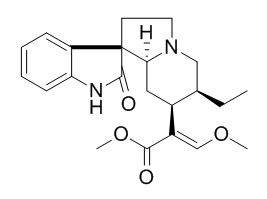Corynoxine
Corynoxine is a natural autophagy enhancer, promotes the clearance of Alpha-synuclein via Akt/mTOR pathway, it can significantly inhibit the oxidative stress of PC12 cells.
Inquire / Order:
manager@chemfaces.com
Technical Inquiries:
service@chemfaces.com
Tel:
+86-27-84237783
Fax:
+86-27-84254680
Address:
1 Building, No. 83, CheCheng Rd., Wuhan Economic and Technological Development Zone, Wuhan, Hubei 430056, PRC
Providing storage is as stated on the product vial and the vial is kept tightly sealed, the product can be stored for up to
24 months(2-8C).
Wherever possible, you should prepare and use solutions on the same day. However, if you need to make up stock solutions in advance, we recommend that you store the solution as aliquots in tightly sealed vials at -20C. Generally, these will be useable for up to two weeks. Before use, and prior to opening the vial we recommend that you allow your product to equilibrate to room temperature for at least 1 hour.
Need more advice on solubility, usage and handling? Please email to: service@chemfaces.com
The packaging of the product may have turned upside down during transportation, resulting in the natural compounds adhering to the neck or cap of the vial. take the vial out of its packaging and gently shake to let the compounds fall to the bottom of the vial. for liquid products, centrifuge at 200-500 RPM to gather the liquid at the bottom of the vial. try to avoid loss or contamination during handling.
Expert Opin Ther Targets.2024, :1-11.
Preprints2024, 2085.v1
Phytother Res.2019, 33(5):1490-1500
J Cosmet Dermatol.2022, 21(1):396-402.
Manomaniam Sundaranar University2023, 3859769.
Daru.2024, 32(2):689-703.
Food Sci Nutr.2019, 8(1):246-256
Int. J. Mol. Sci.2023, 24(20),15294.
Malaysian Journal of Analytical Sciences2023, 27(4):840-848.
J Ginseng Res.2022, 46(1):104-114.
Related and Featured Products
Internal Medicine of China,2013,8(6):586-7.
Study on application of statistical modeling on chromatogram-effect relation in Traditional Chinese Medicine[Reference:
WebLink]
To establish chromatogram-effect model based on inhibitory effect of four alkaloids( rhynchophyline,isorhynchophylline,Corynoxine,Corynoxine B) on oxidative stress of glutamate-induced PC12 cells.
METHODS AND RESULTS:
Based on the chromatogram-effect relation of inhibitory effect of four alkaloids on the oxidative stress of glutamate-induced PC12 cells,SPSS 15. 0 was used to analyse data. Oxidative stress of PC12 cells was significantly inhibited by rhynchophyline and Corynoxine. The spectrum efficient equation was,Y = 44. 301 + 0. 255X 1 + 0. 356X 3( P 0. 05). The deviation of predictive value and true value was no more than 10% by data validation from seven samples.
CONCLUSIONS:
The chromatogram-effect model can be used to predict the effect of uncaria macrophylla wall against the oxidative stress of glutamate-induced PC12 cells.
Phytomedicine. 1999 Jul;6(3):163-8.
Effect on locomotion of indole alkaloids from the hooks of uncaria plants.[Pubmed:
10439480]
METHODS AND RESULTS:
Three predominant Uncariae plants, Uncaria rhynchophylla U. sinensis and U. macrophylla and their indole and oxindole alkaloid constituents were studied for their effect on locomotor response. Water extracts of U. macrophylla and U. sinensis and four indole alkaloids, Corynoxine, Corynoxine B, isorhynchophylline and geissoschizine methyl ether, significantly decreased locomotor activity after oral administration to mice.
CONCLUSIONS:
The depression of locomotor activity upon administration of these alkaloids appears to be due to mediating of the central dopaminergic system.
J Neuroimmune Pharmacol. 2014 Jun;9(3):380-7.
Corynoxine, a natural autophagy enhancer, promotes the clearance of alpha-synuclein via Akt/mTOR pathway.[Pubmed:
24522518]
Parkinson's disease (PD) is the second most common neurodegenerative disorder characterized by the accumulation of protein aggregates (namely Lewy bodies) in dopaminergic neurons in the substantia nigra region of the brain. Alpha-synuclein (α-syn) is the major component of Lewy bodies in PD patients, and impairment of the autophagy-lysosomal system has been linked to its accumulation. In our previous study, we identified an oxindole alkaloid Corynoxine B (Cory B), isolated from Uncaria rhynchophylla (Miq.) Jacks (Gouteng in Chinese), as a Beclin-1-dependent autophagy inducer.
METHODS AND RESULTS:
In this work, we show that Cory, an enantiomer of Cory B, also induces autophagy in different neuronal cell lines, including N2a and SHSY-5Y cells, which is paralleled with increased lysosomal enzyme cathepsin D. In vivo, Cory promotes the formation of autophagosomes in the fat bodies of Drosophila. By inducing autophagy, Cory promotes the clearance of wild-type and A53T α-syn in inducible PC12 cells. Interestingly, different from its enantiomer Cory B, Cory induces autophagy through the Akt/mTOR pathway as evidenced by the reduction in the levels of phospho-Akt, phospho-mTOR and phospho-p70 S6 Kinase.
CONCLUSIONS:
Collectively, our findings provide experimental evidence for developing Cory as a new autophagy enhancer from Chinese herbal medicine, which may have potential application in the prevention or treatment of PD.



